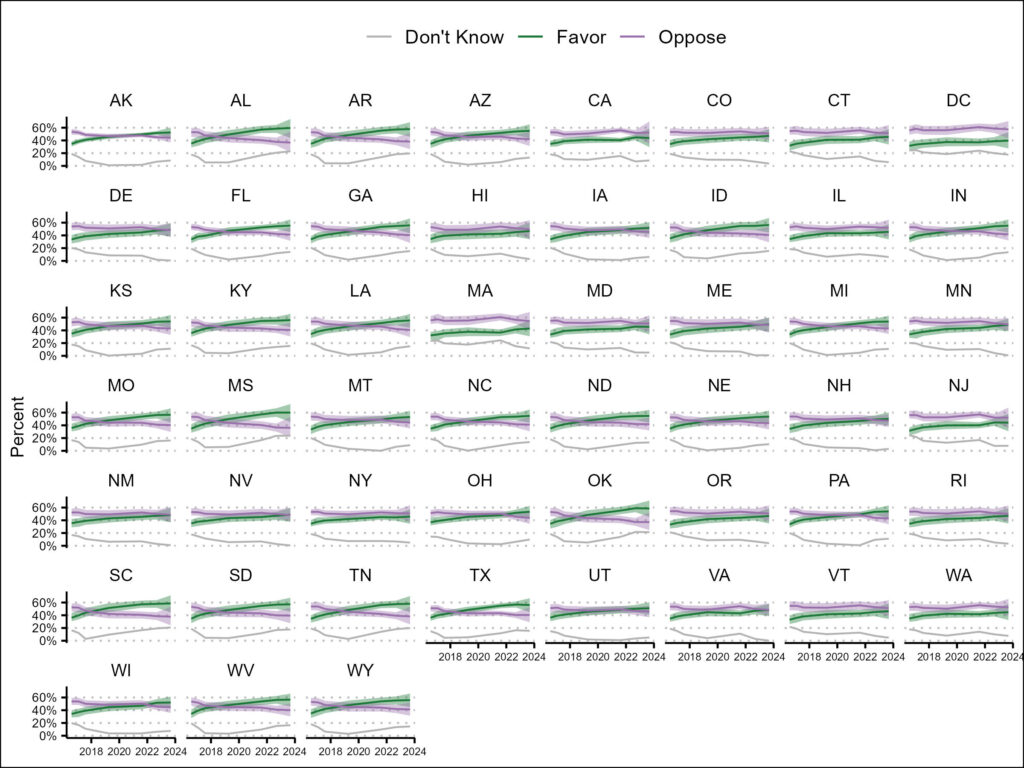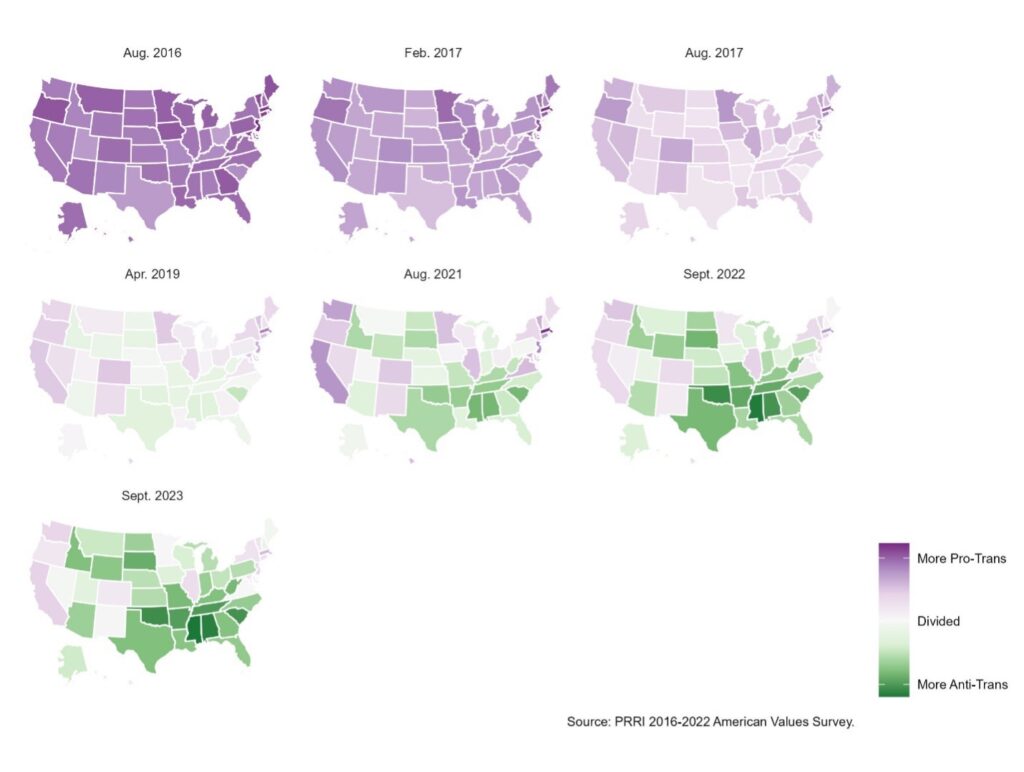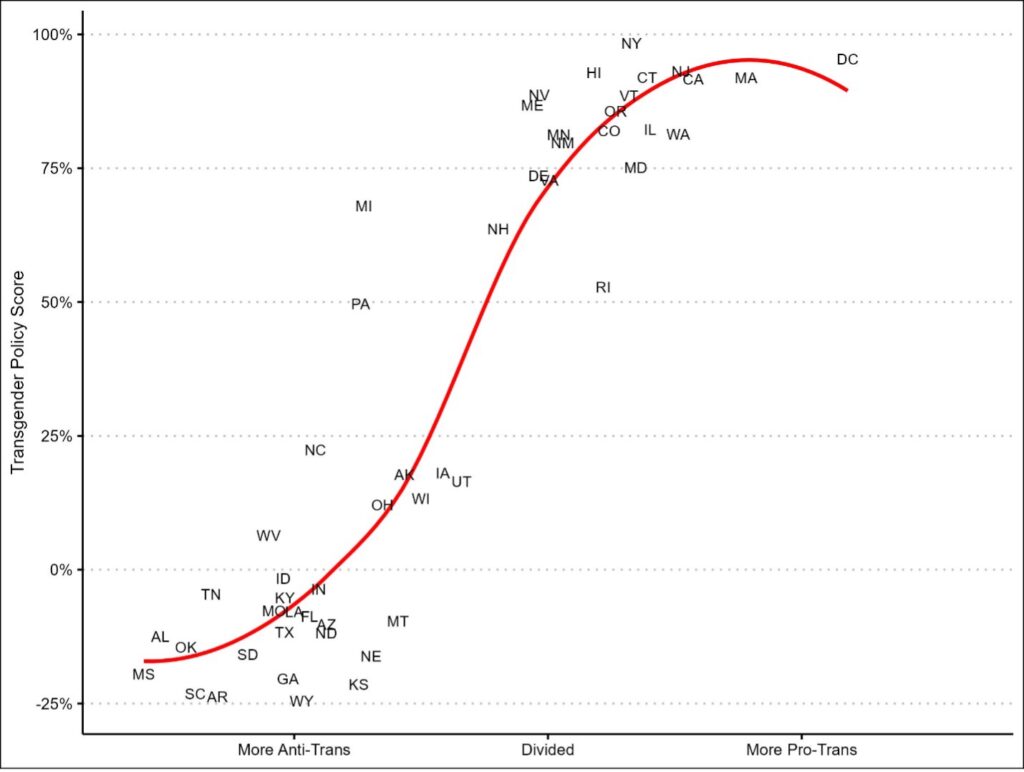Beginning in 2022, PRRI’s American Values Survey noted an increase in public support for policies requiring transgender people to use bathrooms based on their birth sex. It was the only issue that bucked the trend in growing public support for LGBTQ rights. However, in 2022 and 2023, there has been a surge of anti-transgender and anti-gay legislation, and there has been a marked increase in anti-LGBTQ+ rhetoric and demonstrations. Strikingly, the 2023 American Values Survey (AVS) revealed a decline in support for LGBTQ rights across the board.
The public remains broadly supportive of antidiscrimination protections and marriage equality, and a majority reject policies that would allow businesses to refuse services to gay and lesbian people based on their religious beliefs. But the findings suggest a general decline in pro-LGBTQ opinions. For example, about 72 percent of the public supported marriage equality in August 2021, while only 66 percent do in 2023, a drop of 6 percentage points.[1]
As noted in the 2023 PRRI AVS, partisan dynamics tend to be a large indicator of differences of opinion. On support for restrictive bathroom bills, Republican support has shifted from 44% in 2016 to 80 percent in 2023. By contrast, support among Democrats has remained quite stable with 31 percent supportive of such policies in 2023. Political independents have also shifted to be more restrictive in this timeframe, though their opinions have changed little between 2022 and 2023. Prior research has shown that as partisan politicians began to clearly take opposing positions on transgender rights, so too have partisan members of the mass public.
Has the increase in support for restrictive bathroom bills been constant across the United States? A lot of the legislative activity affecting transgender rights is happening at the state level, and I previously showed that statewide opinions on transgender rights was a correlate of the number of anti-transgender legislative proposals at the state level. Also, states are characterized as being “red states,” “blue states,” and “purple states,” according to their respective partisan voting habits. Thus, just as mass partisans have become more polarized, opinion trends at the state level may not be uniform. To investigate this, I relied on PRRI surveys that asked opinions about restrictive bathroom bills (2016-2023), and used a statistical model that can credibly estimate statewide trends in public opinion from nationally representative surveys.
First, I learned that trends in opinions have not been uniform across the United States. Some states have had a relatively stable trend in opposing restrictive bathroom bills. However, other states have taken an opposite trajectory, either becoming more evenly divided, or growing more supportive of restrictive bathroom bills. It is also notable that some statewide opinions have become more certain in their opinions (i.e., fewer people responding “Don’t Know”), but others have shown an increase in uncertainty, usually corresponding with a decline in those opposing restrictive bathroom bills. Notably, some traditional “red states” have been the ones that have been increasing in their favorability of restrictive bathroom policies.
Opinions on Restrictive Bathroom Policies
Do you strongly favor, favor, oppose, or strongly oppose laws that require transgender individuals to use bathrooms that correspond to their sex at birth rather than their current gender identity?

Second, states have generally become more divided on restrictive bathroom policies. The following maps show the difference between the percent favoring and opposing restrictive bathroom policies. In 2016, there were more adults opposing restrictive bathroom policies than favoring them. This has gradually changed over time, with some common red states, particularly in the South and portions of the Midwest, becoming more divided and then more favorable of these policies.[2] Thus, just as partisan divides in mass opinion have occurred, there does appear to be a “red state” and “blue state” divide in opinions, even though all states have become somewhat more divided on this issue. Importantly, this divide started to reveal itself in 2021 before the major surges in legislation.
Opinion Polarization on Restrictive Bathroom Policies

Third, there is a close link between opinions and the policies in place. The Movement Advancement Project scores states based on how inclusive or exclusive the states are in gender identity policies. I compared statewide opinions to these policy scores.[3] There is a very close relationship between opinions and policy, with a correlation of 0.91. While it is less clear whether policy change occurred before or after opinion change, it is worth noting that opinion divides predated some changes. There are clearly links.
What is also noteworthy is the fact that there is geographically a cluster of states that is more anti-trans and another cluster of states that is more pro-trans, with few states in between. I previously wrote that there may be an emergent two Americas for LGBTQ people particularly for transgender people. These data further support that expectation both in policy and public opinion.
The Relationship Between Opinions on Restrictive Bathroom Policies and Transgender Policies, September 2023

Note: Points are jittered; red line is a running average (LOESS).
Sources: PRRI American Values Survey 2023; Movement Advancement Project Equality Maps.
Thus, just as political parties have largely sorted on transgender rights, statewide activity reflects how the states have sorted on transgender rights. What is also clear is that social change is not a one-way ratchet toward greater acceptance of LGBTQ+ people; while younger generations are indeed more accepting than older generations, I previously showed that partisanship can overcome generational divides on attitudes about transgender rights.
With a resurgence of anti-LGBTQ rhetoric, demonstrations, and legislation, there are signals that the anti-LGBTQ turn is shifting norms. Just as the undermining of democratic norms by political elites can shift some in the masses to devalue democratic norms, the anti-LGBTQ turn may be shifting the opinion landscape about LGBTQ people and rights. If subsequent surveys continue to show what the 2023 PRRI American Values Survey reveals, then it is quite possible that the policy landscape in the U.S. for LGBTQ people remains bifurcated and possibly becomes even more divided.
Andrew R. Flores, Ph.D., is a member of the 2023-2024 cohort of PRRI Public Fellows.
[1] This also captures a shift: there are now fewer adults who may have said they do not have an opinion on these policies. In 2016, transgender rights were relatively new to the American public. Thus, some of the increased polarization stems from people expressing their opinions rather than saying that they do not have one.
[2] According to PRRI surveys, support has hovered around the mid-60s to low-70s in recent years. However, other data from the American National Election Studies also reveal declines in favorable attitudes toward LGBT people.
[3] The Movement Advancement Project, an independent organization, created a gender identity “tally” that scores positive and negative policies in a state. They then translate this tally into a percentage to categorize states from most exclusive to most inclusive.